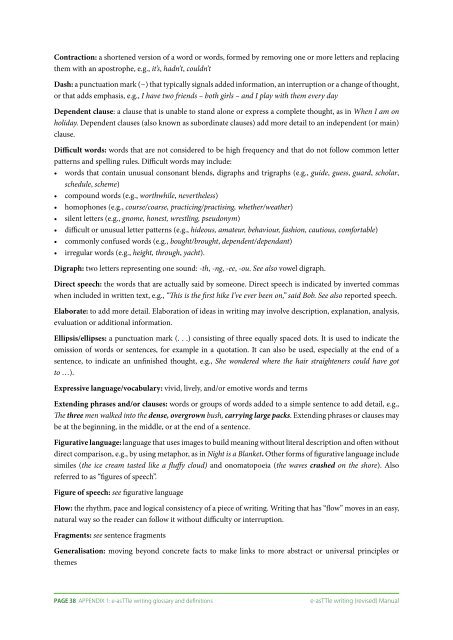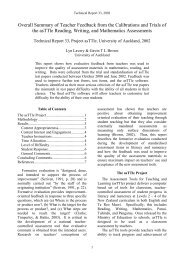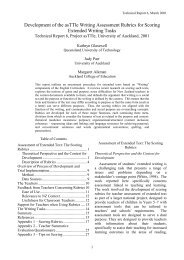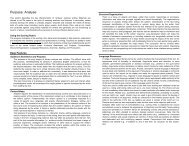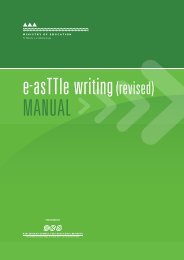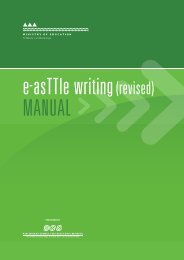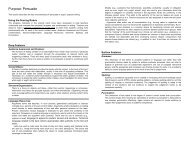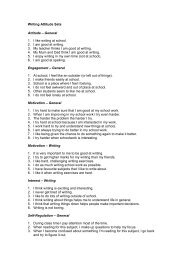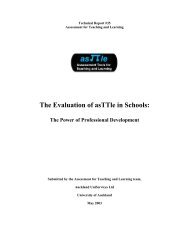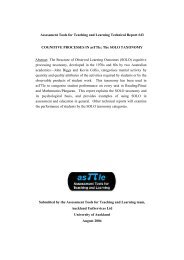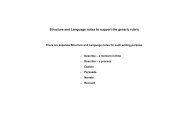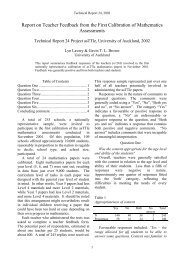e-asTTle writing (revised) Manual 2012 (3).
e-asTTle writing (revised) Manual 2012 (3).
e-asTTle writing (revised) Manual 2012 (3).
- No tags were found...
Create successful ePaper yourself
Turn your PDF publications into a flip-book with our unique Google optimized e-Paper software.
Contraction: a shortened version of a word or words, formed by removing one or more letters and replacingthem with an apostrophe, e.g., it’s, hadn’t, couldn’tDash: a punctuation mark (−) that typically signals added information, an interruption or a change of thought,or that adds emphasis, e.g., I have two friends – both girls – and I play with them every dayDependent clause: a clause that is unable to stand alone or express a complete thought, as in When I am onholiday. Dependent clauses (also known as subordinate clauses) add more detail to an independent (or main)clause.Difficult words: words that are not considered to be high frequency and that do not follow common letterpatterns and spelling rules. Difficult words may include:• words that contain unusual consonant blends, digraphs and trigraphs (e.g., guide, guess, guard, scholar,schedule, scheme)• compound words (e.g., worthwhile, nevertheless)• homophones (e.g., course/coarse, practicing/practising, whether/weather)• silent letters (e.g., gnome, honest, wrestling, pseudonym)• difficult or unusual letter patterns (e.g., hideous, amateur, behaviour, fashion, cautious, comfortable)• commonly confused words (e.g., bought/brought, dependent/dependant)• irregular words (e.g., height, through, yacht).Digraph: two letters representing one sound: -th, -ng, -ee, -ou. See also vowel digraph.Direct speech: the words that are actually said by someone. Direct speech is indicated by inverted commaswhen included in written text, e.g., “This is the first hike I’ve ever been on,” said Bob. See also reported speech.Elaborate: to add more detail. Elaboration of ideas in <strong>writing</strong> may involve description, explanation, analysis,evaluation or additional information.Ellipsis/ellipses: a punctuation mark (. . .) consisting of three equally spaced dots. It is used to indicate theomission of words or sentences, for example in a quotation. It can also be used, especially at the end of asentence, to indicate an unfinished thought, e.g., She wondered where the hair straighteners could have gotto …).Expressive language/vocabulary: vivid, lively, and/or emotive words and termsExtending phrases and/or clauses: words or groups of words added to a simple sentence to add detail, e.g.,The three men walked into the dense, overgrown bush, carrying large packs. Extending phrases or clauses maybe at the beginning, in the middle, or at the end of a sentence.Figurative language: language that uses images to build meaning without literal description and often withoutdirect comparison, e.g., by using metaphor, as in Night is a Blanket. Other forms of figurative language includesimiles (the ice cream tasted like a fluffy cloud) and onomatopoeia (the waves crashed on the shore). Alsoreferred to as “figures of speech”.Figure of speech: see figurative languageFlow: the rhythm, pace and logical consistency of a piece of <strong>writing</strong>. Writing that has “flow” moves in an easy,natural way so the reader can follow it without difficulty or interruption.Fragments: see sentence fragmentsGeneralisation: moving beyond concrete facts to make links to more abstract or universal principles orthemesPage 38 Appendix 1: e-<strong>asTTle</strong> <strong>writing</strong> glossary and definitionse-<strong>asTTle</strong> <strong>writing</strong> (<strong>revised</strong>) <strong>Manual</strong>


